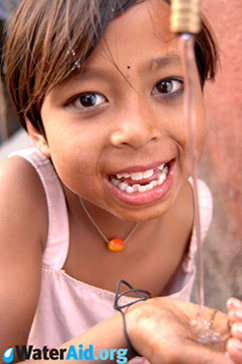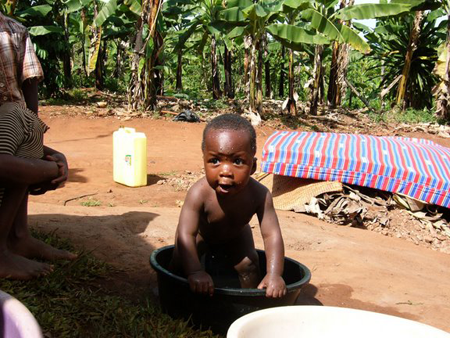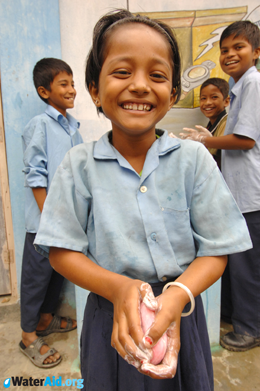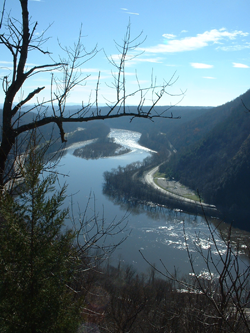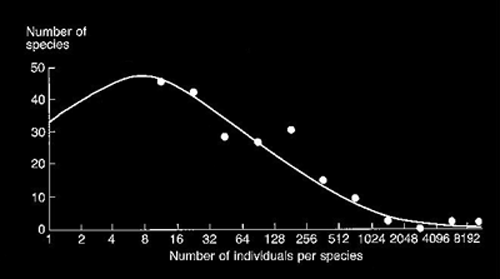Microbes for clean water - discussions and research
Introduction
This story suggests lots of interesting topics for discussion and research.
Take a look at those we've picked out from the text. Compare ours with those you found using the methods in Getting the topics.
In groups discuss the differences. This isn't about right or wrong. Your choices are as good as ours, as long as you can explain and defend them.
Now have a go at some of the topics - ours or yours.
Help with words
After each film clip we explain some of the harder words the researcher uses - and some of the words used in these explanations.
Just mouseover words in any of the lists to get their meaning.
(Resources on this page sponsored by Glasgow University Science Festival.)
Selected topics
Keeping human waste away from drinking water is not glamorous research.
Diseases carried by bad sanitation and water supplies cause 80% of illness and death in developing countries.
The small sewage systems that work best and last longest have the greatest variety of bacteria living in them.
The explorers are tackling it in two different ways – experiments and theory and computer modelling.
But we are engineers. We want to use our knowledge for the benefit of men, women and children around the world.
There are far more bacteria, and different kinds of bacteria, than anybody imagined.
Want more?
Video clips on this page
This means that progess is not as fast as it could be.
What brought Bill into modelling microbes and waste water treatment?
Have a listen to what Bill has to say about microbe biodiversity.
So why was Bill hurtling around the Arctic in a red lifejacket, hunting for microbes and trying not to get eaten by polar bears? Have a listen to how he answers this.
So what is the difference between an engineer and a scientist? Plenty of scientists would say they want to use their knowledge and skills to benefit people. So it can't just be that. Have a listen to Bill on what makes it engineering.
First listen again to what Bill has to say about the result itself - one of the most important that has so far come from mathematical modelling of microbes.
Now let's try to get a feel for the model they developed and described in their paper.
So all Bill and his colleagues need to do is make a few measurements of microbe and species numbers, in the systems they're interested in, then they draw the curve.
If only it were that easy.
And what they imply is that there is incredible diversity of microbes in the world, especially in certain environments such as soil and sewage. They also point the way to achieving the engineering aims of all this research.
Have a listen to Bill Sloan (unedited) on the experimental side of the work and on the surprising and fascinating microbe frozen zoo they have unexpectedly discovered in the Arctic.
Keeping human waste away from drinking water is not glamorous research.
This means that progess is not as fast as it could be, says Bill Sloan.
[Words: fuelled, DNA, techniques, adapted, accelerating, theoretical, sufficient, biologists, legacy, mathematical modeller, inspire, nanotechnology, communications, prosaic, discipline, potential, impact]
"You have to inspire a mathematical modeller to come in and work in a field that's as mucky as waste-water treatment," Bill says.
Imagine you have been given precisely that job. You are part of a team in a marketing consultancy that is being paid to bring more mathematical modellers into the research and improvemenet of waste-water treatment systems.
Working in groups devise a marketing campaign, using persuasive words and effective images, that will do the job.
You might think about some of the following questions to help you along with this project:
-
What was it that brought Bill into modelling microbes and waste water treatment in the first place?
-
Would that be a good angle to use to sell it to others?
-
Is that the only good line you could take? (Remember Bill was already a mathematical modeller before he got into this field.)
-
What kind of rewards and job satisfaction would researchers like Bill get every day, before their long-term goal is achieved?
[Words:significant, impact, statistic, climate change, limited, policy, restrict, engineering, solution]
[More words: gene, inherit, conception, fertilisation, cell, protoplasm, membrane, molecule, theory, system, design, production, electronic, electron, device, atom, fundamental, electric charge, particle, attract, repel]
Diseases carried by bad sanitation and water supplies cause 80% of illness and death in developing countries.
Investigate the connection between bad sanitation and disease, and prepare a presentation.
In doing so you might like to think about and research some or all of the following:
-
What the problem is.
-
Which diseases are most common and deadly
-
Which parts of the world are most affected.
-
What people have to do to survive.
-
What is being done now to help them, and what more could be done.
-
What the answer is in the long-term, if there is one.
Places to start include the Health and hygiene slide show at Oxfam Education, as well as the Global statistics activity, Water Aid and UNICEF
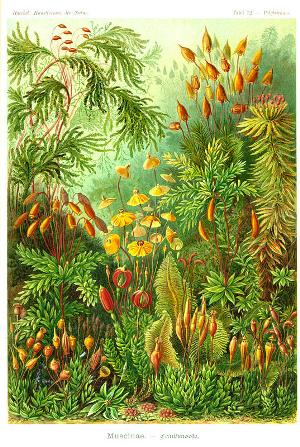
The small sewage systems that work best and last longest have the greatest variety of bacteria living in them.
This is interesting and brings to mind Charles Darwin's often-quoted words:
"It is interesting to contemplate an entangled bank, clothed with many plants of many kinds, with birds singing on the bushes, with various insects flitting about and with worms crawling through the damp earth, and to reflect that these elaborately constructed forms, so different from each other, and dependent on each other in so complex a manner, have all been produced by laws acting around us."
Have a listen to what Bill has to say about microbe biodiversity.
[Words: organism, function, species, consuming, ammonia, stable, bacteria, population, correlation, biodiversity, stability]
In your own words and just a few sentences try to explain what he is saying here. Would you expect to find this connection between stability and biodiversity in other types of ecosystem, apart from microbes?
Is there any evidence for this? (Further reading: Diversity and stability.)
[More words: breed, fertile, microscopic, observed, variety, disturb]
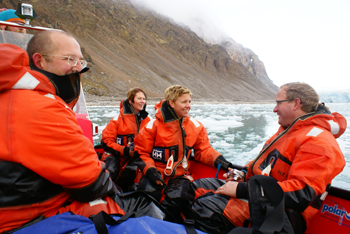
The explorers are tackling it in two different ways – experiments and theory.
It's clear from what we've heard so far that Bill Sloan's research is on the theory and computer modelling side.
He works closely with Tom Curtis and other researchers at Newcastle University, but they are the experimentalists and he is the theorician.
So why on Earth was Bill hurtling around the Arctic in a red lifejacket, hunting for microbes and trying not to get eaten by polar bears?
Have a listen to how he answers this.
[Words: extract, characterise, DNA, environment, model, conceptual, microbial, communities, collaborations]
So what is the answer to our question? How are Bill Sloan's mathematical models improved if he leaves his nice, warm office in Glasgow, goes digging for bugs, sailing in small boats in the Arctic and taking his chances with the Polar Bears of Svalbard?
In groups put together a sentence, in your own words, to anwer this question.
[More words: molecule, atom, particle, element, gene, DNA, inherit, conception, fertilisation, sperm, cell, protoplasm, membrane, microbe, microscopic, environment, bacterium, virus, protein, complex, tissue]
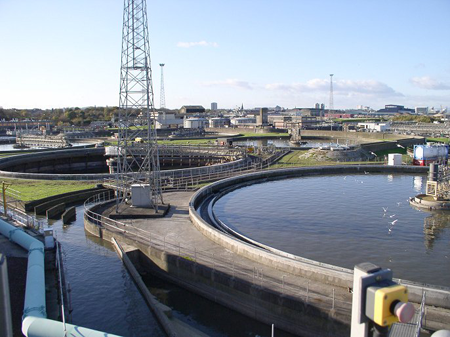
But we are engineers. We want to use our knowledge for the benefit of men, women and children around the world.
So what is the difference between an engineer and a scientist? Plenty of scientists would say they want to use their knowledge and skills to benefit people. So it can't just be that.
Have a listen to Bill on what makes it engineering.
[Words: insight, experimentation, characterise, DNA, social, environmental, focusing, substantial, design, theories, civil engineering, process, fundamental]
Besides making major advances in specialist fields such as thermodynamics, the man Bill Sloan mentions in this clip - Glasgow University's William MacQuorn Rankine - was a practical engineer and a very appealing character.
He mixed readily with both shipbuilders and academics, played the piano at parties and even wrote poetry. Professor Rankine did more than anyone to create modern engineering.
Research and deliver to your class a short presentation on Rankine's life, personality and achievements..
[More words: molecule, gene, inherit, conception, fertilisation, sperm, cell, protoplasm, membrane, welfare, engineering, specialise, design]
There are far more bacteria, and different kinds of bacteria, than anybody imagined.
Let's take a slightly closer look at the mathematical modelling, backed up by experimental results, that led to this conclusion. In the process we'll get a better flavour for what Bill and his colleagues are doing.
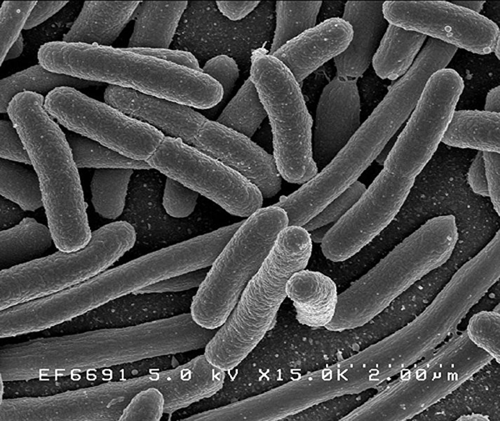
First listen again to what Bill has to say about the result itself - one of the most important that has so far come from mathematical modelling of microbes.
[Words: paper, estimating, species, organisms, environments, diverse, DNA, biodiversity]
Now let's try to get a feel for the model they developed and described in their paper.
[Words: ecology, characterise, communities, relative, abundance, species, dominant, rare, statistical distribution, sample, lognormal]
So Bill decided to use the lognormal and see where that got him. But the lognormal isn't just one curve. It's a huge family of them - in the same way as a parabola isn't one curve but a whole family.
It takes a good spread of measurements from tne real world to tell you exactly which member of the family you've got, in any environment you're interested in.
So for example in the curve below, which is for species of moths on an island, the blobs are the experimentally measured points and the curve is the best smooth line drawn through them.
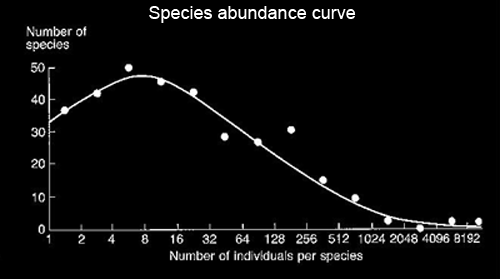
That line then becomes our model. It can tell us a great deal about the species that are out there, and the number of individuals belonging to each of them.
In particular it can tell us the total number of different species on the island, from the area under the curve.
If we know a curve like this holds for moths in all environments we have a powerful way of finding out about individuals and species in a new location - and what measurements we need to find out more.
If we know a curve like this holds for microbes in all environments (soil, ocean, atmosphere, etc.) we have a powerful way of finding out about individuals and species in a new location - such as a small sewage system - and what measurements we need to find out more.
So all Bill and his colleagues need to do is make a few measurements of microbe and species numbers, in the systems they're interested in, then they draw the curve.
If only it were that easy.
[Word: DNA, extraction, conscious, sample, ten to the, millilitre, extract, organisms, species, characterise, insight, biodiversity, extrapolate, mathematical model]
Let's explore this problem a little.
In groups, take a look at our moth species abundance curve and come up with a few sentences that explain in words what it's showing - what it says about moths and moth species on the island. Mention in particular the x-axis and the y-axis, and how the y-axis variable behaves at small and large values of the x-axis variable. What happens at in-between values? Notice that there's something unusual about the values on the x-axis. What is it and why has it been done, do you think?
Why is the origin of the x-axis not zero, as it usually is with graphs?
Near zero is actually a problem for any species abundance curve. Have a think and discuss in your groups why this might be so, before reading on.
Near zeros is always a problem because the left hand part of the curve deals with species that don't have many members - rare species. And if they are rare they're harder to find. So researchers will get only a few experimental points there, and those they get will be pretty inaccurate.
Suppose for example that our moth-catchers missed all those species that had less than five individuals in them.
We would then have no good reason to draw the curve like this at all.
It could just as easily look like any one of those below - or indeed any other shape you fancy as it heads off to the left.
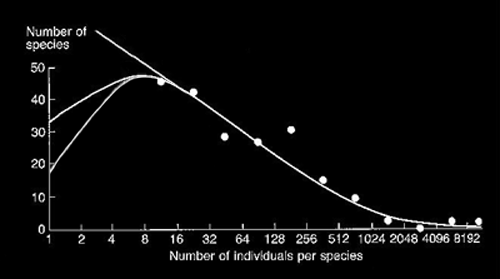
For microbe populations it's not just two points we're missing, it's hundreds of points. It's not just Lithuanians or Tibetans, as Bill mentions, that we don't find on our bus. There's practically no chance of picking up anyone from Monaco, Iceland, Belize, Fiji, Samoa, Qatar, Dominica, Seychelles, Luxembourg...
Experimental methods are improving all the time. But in microbe systems the scientists are really still only picking up those microbes there are most of - the Chinese, Americans, Indians, Indonesians, Brazilians.
So Bill's task was to come up with a method of building a curve for the whole of a microbe ecosystem, given far fewer measurements than he really needed - a map of world population when all he had was information about the largest countries.
What do researchers do in that kind of situation? They use their imagination. They make inspired guesses. They think up assumptions they might make. Then they work out what all these might mean for the real world. And they go out and test them. Or their experimental colleagues do.
If the real world says the guesses were garbage, they put on the percolator, chat to their mates, scratch their heads and try again. It's called the scientific method, sometimes.
We've already heard about the biggest of Bill's assumptions - that the species abundance curve for microbe populations is lognormal. A good model makes as few assumptions and uses as much real-world knowledge as possible. So what other assumptions did Bill make?
Not many.
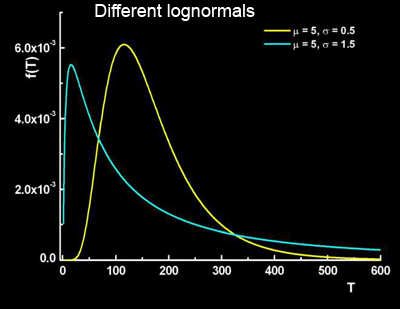 If the species abundance is lognormal, lots of experimental measurements would let us write down its equation. That equation would then tell us which member of the lognormal family we actually had.
If the species abundance is lognormal, lots of experimental measurements would let us write down its equation. That equation would then tell us which member of the lognormal family we actually had.
(Again this is the same as for the parabola family y = ax 2 + bx + c. Knowing the value of the constants a, b and c tells us which member of that family we're dealing with.)
Knowing the lognormal equation would be incredibly useful. it would mean for instance that we could easily calculate the total number of species in the system.
The values of three constants in the lognormal equation fix the family member. If we could measure these three we'd be home. But we can't. One in fact is the total number of species in the system - and we're doing all this modelling mainly because we want to know that and can't measure it.
But Bill shows mathematically in his paper that a lognormal can be re-written in terms of three other constants that can, in principle, be measured. He suggests two possible assumptions for estimating one of these, and works out what these assumptions would imply for numbers of microbe species.
And what they imply is that there is incredible diversity of microbes in the world, especially in certain environments such as soil and sewage. They also point the way to achieving the engineering aims of all this research.
[Words: cite, heralded, biodiversity, experimental, progressed, characterise, genes, DNA, organisms, distinguish, species, function, environment, dispersal, location, dictates, promote, insight, social, fundamental, engineering]
The paper by Bill Sloan and Tom Curtis concludes with these words:
"Microbial ecology, which drives the ecology of the planet, urgently requires approximate theoretical and experimental descriptions of the whole to complement the trend to ever more perfect experimental descriptions of the parts."
So there is plenty of work still to be done.
We'll come back in a few months' time and take a look at some of that work.
In the meantime you might like to listen to Bill Sloan below on some of the recent discoveries he and his colleagues have been making - and what they might mean for the future.

[More words: journal, conference, model, confirm, breed, fertile, molecule, gene, inherit, conception, fertilisation, cell, protoplasm, membrane, sperm, variety, relate, environment, litre, maximum, density, prediction, welfare]
Want more?
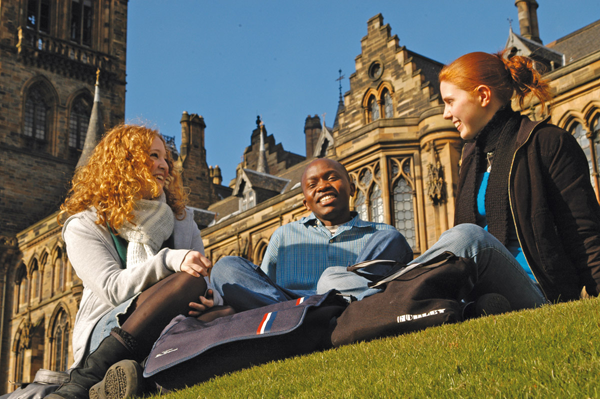
1. Have a listen to Bill Sloan (unedited) on the experimental side of the work and on the surprising and fascinating microbe frozen zoo they have unexpectedly discovered in the Arctic.
2. Life is lognormal and a computer game that generates lognormal distrbutions.
3. Welcome to the Microbe Zoo
4. Curtis, T.P. Sloan, W.T. & Scannell, J.W., 2002. Estimating prokaryotic diversity and its limits. PNAS August 6, 2002 vol. 99 no. 16 10494-10499 is available online. The journal also published in the same issue a commentary by Princeton University's Bess Ward, which puts the findings in context and helps explain their importance at the time (although things have moved on since, particularly in terms of what can be done experimentally.)
5. Water for kids - a selection of educational resources.
6. Seafield Wastewater Treatment Works.
7. Education from Scottish Water - includes link to interactive game right at the foot of the page.
8. Facing the freshwater crisis from Scientific American.
9. Cool bacteria.
10. Tom Curtis at Newcastle University.
11. Educational resources from Oxfam Education, Unicef and WHO.
12. Primary and Secondary resources from the charity Water Aid.
13, Education from Scottish Water.
14. Water cycle animation.
15. Understanding your water lesson plan.
16. "World sewage plans should be abandoned."
17. Lots of links.

